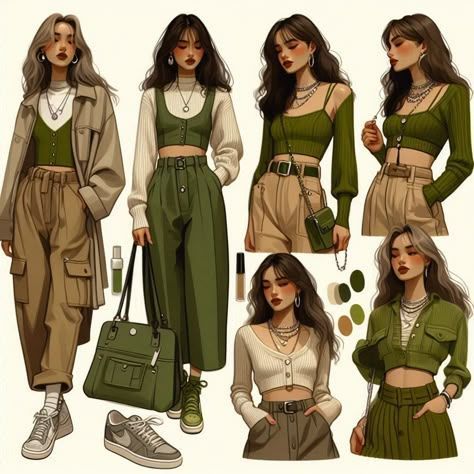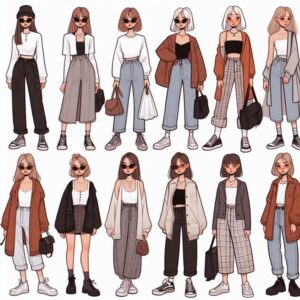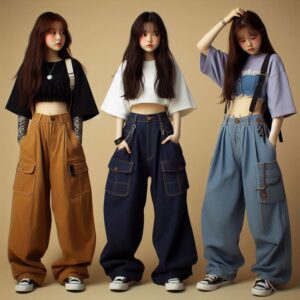
Kavindya Senevirathna



Fashion is not just about simple clothes and beauty, but also a special medium that reflects the culture, tastes, and identity of society. In every era, generations have invented new styles and built them in innovative ways according to their feelings and moods. However, there is a unique characteristic that can be observed in the style of the modern Gen Z generation. That is, while they embrace novelty, they have also brought the traditional styles of the past back to life.
Baggy jeans from the 90s, oversized blazers from the 80s, floral patterns from the 70s, or Y2K fashion from the 2000s are examples that clearly demonstrate the fashion tastes of the Gen Z generation. For them, fashion is not just about following the latest trends, but also about expressing their identity and social values in fresh and creative ways. The resurgence of these styles, which spreads across the globe through social media, highlights their strength, creativity, and innovative spirit as a generation.
The popularity of sustainable consumption, thrift shops, retro fashion, and DIY trends among them is also a testament to this cultural revival. Repurposing something old is not only a fashion statement for them, but also a statement to society. In doing so, Gen Z is exemplifying a new fashion culture that harmoniously combines the past and the present.
The Return of Old Fashion: The Tastes and Appeal of Modern Gen Z
The modern Gen Z generation lives in an era of rapidly changing technology and continuously evolving styles. Yet there is a surprising pattern in their tastes and appeal: they are embracing old fashion, styles that were not originally available to their generation. This is not merely a love of tradition, but an attempt to express themselves in new ways, reflecting modern society, fashion, cultural values, and their own emotions.
A major reason for the revival of old fashion is that Gen Z presents their identity through social media. Platforms like TikTok, Instagram, and Pinterest allow them to showcase their fashion creatively. While they seek innovative designs, they also find the simple, comfortable, and meaningful styles of the past irresistible. This is why baggy jeans from the 90s, oversized blazers from the 80s, and floral prints from the 70s are gaining popularity once again.
Another important aspect of embracing old fashion is sustainability. Gen Z recognizes the value of repurposing old items rather than constantly buying new goods. The popularity of thrift stores, second-hand markets, and vintage shops serves as evidence of this sustainable approach.
Through this practice, Gen Z demonstrates that fashion is not just about chasing the latest trends, but also about reinterpreting the beautiful aspects of the past. Their passion and taste are giving fashion a renewed meaning and cultural significance.
Retro and Vintage Habits: Gen Z Reimagines New Fashion
Retro and vintage are two key concepts that define the appeal of the modern Gen Z generation. Retro represents a reimagining of past fashions, while vintage refers to styles that are old but still retain quality and fashion value. Both concepts influence the contemporary fashion culture among Gen Z, shaping their identity and societal presence.
Gen Z is a generation that seeks new experiences but also values the simplicity and uniqueness of the past. For example, the resurgence of Polaroid cameras, the return of cassette tapes and vinyl records, and the Y2K trend becoming a social media phenomenon all illustrate their love for retro and vintage aesthetics.
Another important point is that the adoption of retro and vintage fashion is connected to their “new attitudes.” Simply put, Gen Z lives in a modern era but uses old fashion to express their emotions and tastes in contemporary ways. Old graphic tees, crop tops, platform shoes, mom jeans, and similar items are becoming “cool” again.
The influence of retro and vintage fashion extends beyond clothing and affects their entire lifestyle. The reintroduction of vintage furniture, old songs, simple museum cultures, and historic patterns in architecture all form part of this trend.
Thus, the use of retro and vintage fashion by Gen Z demonstrates their creativity as a generation and their ability to seamlessly combine the old with the new.
Social Media, New Concepts, and Vintage Fashion: The New Fashion Culture of Modern Youth
In today’s world, social media is an essential part of Gen Z’s life. They use these platforms to express their feelings, ideas, and fashion trends. Social media has played a crucial role in the revival of vintage fashion and the evolution of new fashion concepts for the younger generation.
The resurgence of 2000s low-rise jeans on TikTok, 90s makeup trends on Instagram Reels, and the popularity of thrift fashion boards on Pinterest exemplify how Gen Z is bringing vintage fashion back to life. Social media not only introduces new fashion influences but also allows Gen Z to share their retro and vintage tastes with the world.
Their style is further enhanced by new concepts. Many follow sustainable fashion practices, DIY clothing trends, and upcycling techniques. Cutting old jeans into new designs or painting old bags to give them a fresh look illustrates how Gen Z merges the new with the old in their fashion expression.
Such trends also shape their identity. For Gen Z, fashion is not simply about clothing but serves as a powerful medium to express cultural values and ideas. Fashion can convey social messages, environmental awareness, and economic ideologies.
Consequently, Gen Z’s revival of old fashion through social media and innovative concepts is creating a new fashion culture; a cultural intersection where past and present, fashion and culture, sustainability and design coexist harmoniously.
The modern Gen Z generation’s attitude toward fashion is not a mere clash of tastes but a cultural trend that unites past and present. While they live in an era defined by advanced technology and social media, they are breathing new life into old fashion and retro practices. This demonstrates that fashion is about reviving the beautiful values of the past, even as time progresses.
Gen Z expresses sustainability, creativity, and a clear statement of their identity through fashion. Thrift shops, vintage collections, DIY creations, and sustainable fashion allow them to present the simplicity and charm of past patterns with a modern twist. Through these practices, they show that fashion is not only about clothing but also about conveying values, ideas, and cultural heritage.
The reuse of old fashion affects not only Gen Z but also the global fashion industry. Emerging designers and brands draw inspiration from their love of retro and vintage, reintroducing forgotten patterns and styles to contemporary audiences.
Thus, Gen Z’s repurposing of past fashions can be seen as a new chapter in the history of world fashion. They illustrate that fashion is a powerful medium capable of preserving cherished memories of the past and reimagining them in ways that resonate with a new generation.